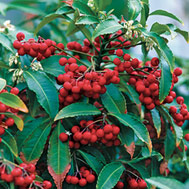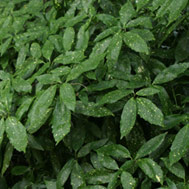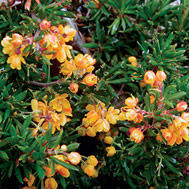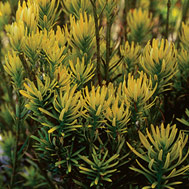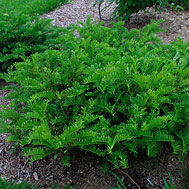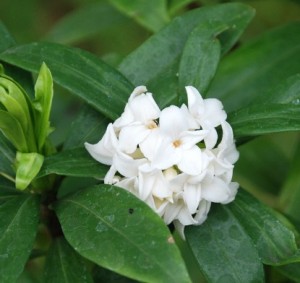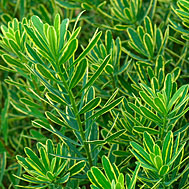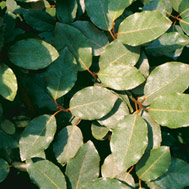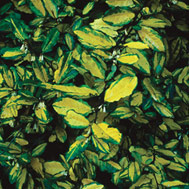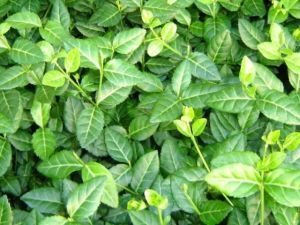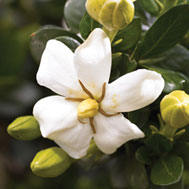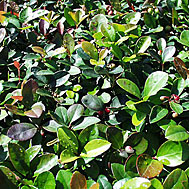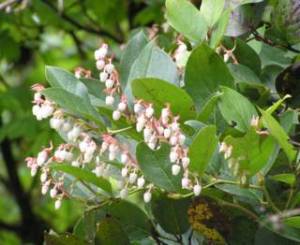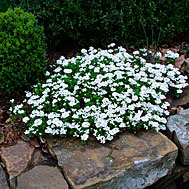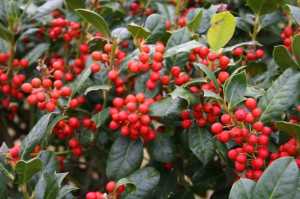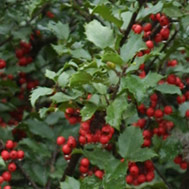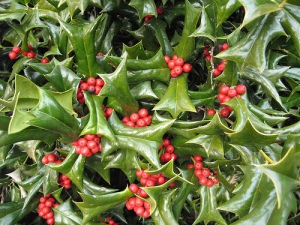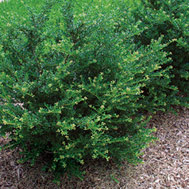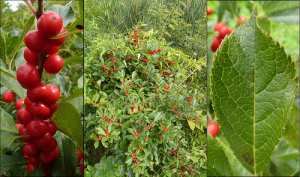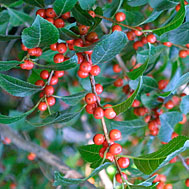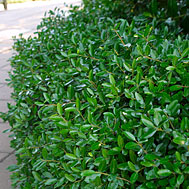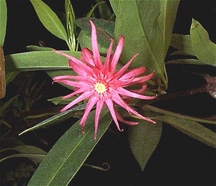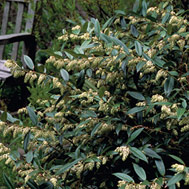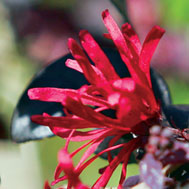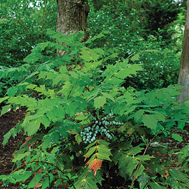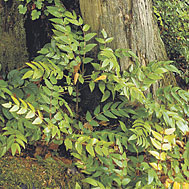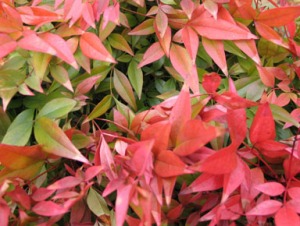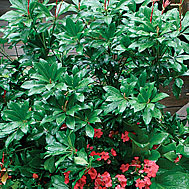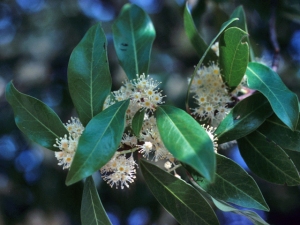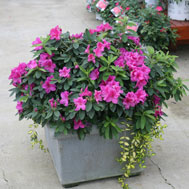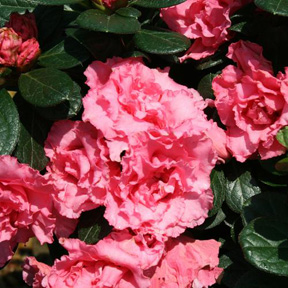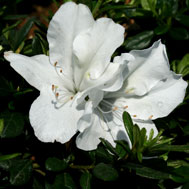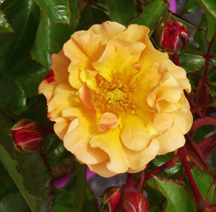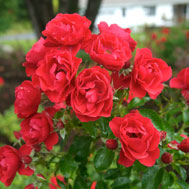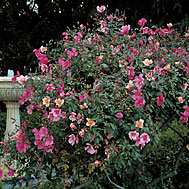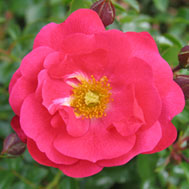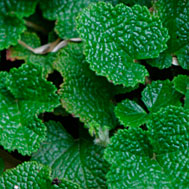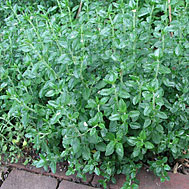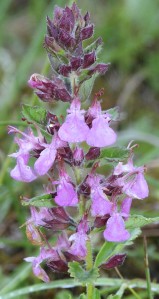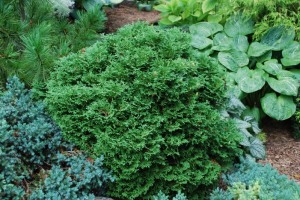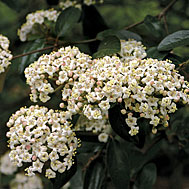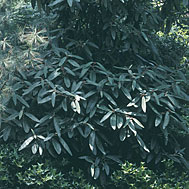Botanical Name: Ardisia crenataar-DIS-ee-ah kren-AY-tah
Common Name: Coralberry, Spiceberry
This shrub produces abundant, long-lasting, coral-red to scarlet berries, which stand out against dark-green, glossy leaves.
Noteworthy characteristics: Shows off in winter, with its evergreen foliage and bright red berries.
Propagation: Root semi-ripe cuttings in summer.
Problems: Fungal root rot, fungal stem and leaf diseases. Mealybugs.
__________________________________________________________________________________
Botanical Name: Aucuba japonica ‘Variegata’ah-KEW-bah jah-PON-ih-kah
Common Name: Gold-dust plant
The dense, glossy foliage of this evergreen plant is splattered with yellow. Gold-dust plant can be planted near nearby tree roots, and it responds well to pruning. Combine it with yellow-blooming or variegated plants for appealing color harmonies. -Debra Lee Baldwin, Regional Picks: Southern California, Fine Gardening issue #127
Noteworthy characteristics: Poisonous.
Care: Plant in average, well-drained soil.
Propagation: From cuttings.
__________________________________________________________________________________
Botanical Name: Aucuba japonicaah-KEW-bah jah-PON-ih-kah
Common Name: Japanese laurel
Aucuba are grown for their bold foliage, autumn fruit, and adaptability to shade, dry soil, pollution, and coastal conditions. A. japonica is a rounded, evergreen shrub with small, reddish purple flowers in spring, and red berries (on female plants) in fall. It grows to about 10 feet tall and wide. ‘Crotonifolia’ has leaves that look like they were speckled with yellow paint. ‘Gold Dust’ is female with heavy yellow speckling. ‘Mr. Goldstrike’ is male, more upright, and has gold-splashed leaves. Use as a hedge or specimen, in a container outdoors, or as an imposing houseplant.
Noteworthy characteristics: Very adaptable; glossy, bold foliage; red berries on female plants. Many named cultivars are female and thus bear autumn fruit.
Care: This plant is tolerant of full shade, dry soil, pollution, and salt winds. It’s adaptable to almost any soil, except waterlogged soil. Use it in full sun to part-shade, or in full shade in hot summer areas. Protect from winter sun and wind at lower zones. Trim or cut back in spring.
Propagation: Root semi-ripe cuttings in summer. Sow seed in containers in a cold frame in autumn.
Problems: Wet root rot, Southern blight, fungal leaf spots.
__________________________________________________________________________________
Botanical Name: Berberis × stenophylla ‘Corallina Compacta’BER-ber-iss ex sten-oh-FIL-lah
Common Name: Compact coral barberry
“Thorny but irresistible” best describes this low-maintenance, elfin barberry. Tiny leaves are smothered in coral-colored buds opening to bright yellow-orange spring flowers. These, in turn, produce silver-frosted, blue-black berries in fall. ‘Corallina Compacta’ is evergreen, tolerates most soil types, and is pest-free and drought tolerant once established.
Noteworthy characteristics: Colorful flower buds and blooms on a compact plant; attractive berries; evergreen; adaptable.
Care: Provide full sun to partial shade and most any well-drained soil. Tolerates light shade and drought, but not wet soil.
Problems: Infrequent.
__________________________________________________________________________________
Botanical Name: Camellia japonicaka-MEE-lee-ah jah-PON-ih-kah
Common Name: Camellia
Japanese camellias shine in winter, with their glossy, deep green leaves and brilliant symmetry. Red, pink, and white lowers appear in spring, and they range from solids to stripes and from single cups of petals to tight double blooms. -Nellie Neal, Regional Picks: Southeast, Fine Gardening issue #127
Care: Moist, rich, well-drained, acidic soil. Camellias need extra water during dry summers. Horticultural oil spray applied after flowering prevents scale and other insects.
Propagation: From cuttings.
__________________________________________________________________________________
Botanical Name: Cephalotaxus harringtonia ‘Korean Gold’sef-ah-lo-TAKS-us hair-ring-TOE-nee-ah
Common Name: Plum yew
Synonyms: Cephalotaxus harringtonii ‘Korean Gold’
This slow-growing dwarf conifer has a wide, rounded crown and narrowly furrowed, partially peeling bark. Three-inch-long needles emerge tipped in gold before aging to green in winter.
Noteworthy characteristics: Perfect for tight spaces. Reaches half its mature size in 15 years. May be hardy in Zone 5 if protected from wind.
Care: Grow in moist, well-drained soil.
Propagation: Root greenwood or semi-ripe cuttings cuttings of terminal shoots in summer or autumn. Cuttings from sideshoots seldom develop normally.
Problems: Infrequent.
__________________________________________________________________________________
Botanical Name: Cephalotaxus harringtonii ‘Prostrata’sef-ah-lo-TAKS-us hair-ring-TOE-nee-ah
Common Name: Plum yew
This slow-growing dwarf conifer has a wide, rounded crown and narrowly furrowed, partially peeling bark. Needles, 1 to 1.5 inches long, are arranged on V-shaped ranks on each shoot.
Noteworthy characteristics: Perfect for tight spaces. Reaches half its mature size in 15 years. Spreading and low-growing cultivar.
Care: May be hardy in Zone 5 if protected from wind. Grow in moist, well-drained soil.
Propagation: Root greenwood or semi-ripe cuttings cuttings of terminal shoots in summer or autumn. Cuttings from side shoots seldom develop normally.
Problems: Infrequent.
__________________________________________________________________________________
Botanical Name: Daphne × burkwoodii ‘Carol Mackie’DAF-nee ex burk-WOOD-ee-eye
This celebrated hybrid is notable for its green leaves with golden-yellow margins that fade to cream. Its deep-pink buds open to pale, pink-white blossoms in early spring and give off a sweet fragrance.
Noteworthy characteristics: These shrubs are gems in the open woodland and shrub border, or for specimen planting. Daphnes have the reputation of being finicky and perishing without warning, but in general, they are beautiful, low-maintanence shrubs.
Care: Grow in humusy, well-drained soil that does not dry out. Mulch to keep roots cool. Daphne do not like to moved, so choose a permanent location. Established shrubs can be maintained by pruning after flowering.
Propagation: Sow seed in a cold frame when fresh; take softwood cuttings in early summer and hardwood cuttings in late summer.
Problems: Southern blight, Verticillium wilt, crown and root rot, Botrytis twig blight, aphids, and scale.
__________________________________________________________________________________
Botanical Name: Daphne odoraDAF-nee OH-dor-ahCommon Name: Winter daphne
This evergreen species produces rose-purple buds that open to white and are intensely and exotically fragrant. The blooms (from mid-winter to early spring) are followed by red fruit and dark-green, glossy leaves.
Noteworthy characteristics: These shrubs are gems in the open woodland and shrub border, or for specimen planting. Daphnes have the reputation of being finicky and perishing without warning, but in general, they are beautiful, low maintanence shrubs.
Care: This species prefers filtered shade and heavy pruning to keep it full.
Propagation: Sow seed in a cold frame when fresh; take softwood cuttings in early summer and hardwood cuttings in late summer.
Problems: Southern blight, Verticillium wilt, crown and root rot, Botrytis twig blight, aphids, and scale.
__________________________________________________________________________________
Botanical Name: Elaeagnus pungensel-ee-AG-nus PUN-jenz
Common Name: Thorny elaeagnus
This is a tough evergreen shrub with pendent flowers that provide a delightful gardenia-like perfume during October and November. Brown fruit ripens to red in autumn. Handsome foliage is a lustrous green above, dull and silvery dotted with brown below.
Noteworthy characteristics: Not for the small garden, this aggressive grower is considered a weed by some, and it is impervious to pests, pollution, and salt spray, making it an ideal candidate for hedges, screening, and bank plantings.
Care: Elaeagnus pungens thrives in the sun or shade, and in all types of soil.
Problems: Occurring frequently: cankers, dagger nematode, dieback, rust, fungal leaf spots, and root rot. Can be aggressively weedy.
__________________________________________________________________________________
Botanical Name: Elaeagnus pungens ‘Maculata’el-ee-AG-nus PUN-jenz
Common Name: Variegated silverberry
Synonyms: Elaeagnus pungens ‘Aureovariegata’
This evergreen shrub can light up the dark corners of a garden. It grows quickly, and its branches are arched and somewhat spiny. Bright yellow, 3- to 4-inch-long leaves splashed are outlined in green. The twigs are a metallic copper color, and the undersides of the leaves are specled with a copper color, too. Tiny white flowers appear under the leaves in fall. They are hard to see, but very fragrant. Small orange fruit appear in spring. -Michael Lee, Fine Gardening issue #119
Noteworthy characteristics: Great fragrance, spring fruit. Extremely durable plant.
Care: Grow in full sun to full shade in any soil. Once established, it won’t need any supplemental water.
Propagation: From hardwood or softwood cuttings; from seed.
Problems: Dieback, rust, root rot, cankers, dagger nematode, fungal leaf spots.
__________________________________________________________________________________
Botanical Name: Ephedra equisetinaef-ED-drah ek-wih-seh-TEE-nah
Common Name: Bluestem joint fir
A member of the conifer clan, Ephedra equisetina is commonly called bluestem joint fir due to its finely textured blue stems. In spring, it features a conspicuous froth of yellow blooms that are often followed by red berries. It is perfect for naturalized areas since it reliably spreads.
Noteworthy characteristics: Dense branching provides excellent winter interest. Yellow blooms and red berries. Heat and drought tolerant.
Care: Prefers full sun to partial shade and grows well in garden loam, clay, or sandy soil. It can take moderately moist to xeric conditions and is extremely heat and drought tolerant, which makes it a good choice for groupings in difficult areas.
Propagation: Sow seed in containers in an open frame in autumn. Divide in spring or autumn.
Problems: Rust can occur.
__________________________________________________________________________________
Botanical Name: Euonymus fortunei cvs.yew-ON-ih-mus for-TOON-ee-eye
Common Name: Wintercreeper
Prostrate to mound-forming, vigorous evergreen shrubs have oval, toothed, dark green leaves. Cultivars vary in foliage color and variegation, form, climbing or creeping habit, and fall interest.
Noteworthy characteristics: Best used as a groundcover, as it may suffer winter burn in cold climates. Highly invasive, spreading by bird-dispersed berries.
Care: Variegated cultivars may need sun to enhance leaf color. Vigorous climber if given support or can be trained against a wall or tree.
Propagation: Root semi-ripe cuttings. Sow seeds in containers in a cold frame.
Problems: Common in euonymus: mites, scale insects, leaf miners, aphids, and mealybugs. Frequent: witches’ broom, stem dieback, powdery mildew, and fungal spots.
__________________________________________________________________________________
Botanical Name: Gardenia augusta ‘MADGA 1’
Common Name: Heaven Scent® gardenia
This gardenia cultivar features a very tight, upright form that is perfect for smaller gardens. It also boasts increased cold tolerance while maintaining the lustrous dark green foliage and abundant fragrant blooms you’ve come to expect from this genus.
Noteworthy characteristics: Fragrant flowers; ornamental fruit; dark glossy foliage; compact habit, increased cold tolerance.
Care: Gardenias don’t require special care if they are planted in a suitable location.
Propagation:
Propagation of this cultivar is prohibited.
__________________________________________________________________________________
Botanical Name: Gaultheria procumbens
Common Name: Wintergreen, Checkerberry
This creeping, rhizomatous shrublet grows to 6 inches, with scalloped or bristly toothed, glossy, dark green leaves. Foliage has a strong wintergreen scent when crushed. Urn-shaped white or pale pink flowers appear in summer and mature to aromatic scarlet fruit that often persists into the following spring.
Noteworthy characteristics: This native of eastern North America is suitable for woodland plantings, rock gardens, or heather gardens. Edible fruits.
Care: Grow in acidic to neutral, peaty, moist soil in partial shade. Tolerates full sun if soil is permanently moist.
Propagation: From semi-ripe cuttings in summer, or remove rooted suckers in spring.
Problems: Black mildew, powdery mildew, leaf gall, fungal spots.
__________________________________________________________________________________
Botanical Name: Gaultheria shallon
Common Name: Salal, Shallon
This compact, bushy shrub has red shoots and ovate, pointed, glossy dark green leaves. Arching racemes of urn-shaped white flowers tinged with pink appear in late spring and early summer, maturing to fleshy, spherical, purple fruit measuring a half-inch across.
Noteworthy characteristics: This native of western North America spreads vigorously by suckers. Suitable for woodland plantings, rock gardens, or heather gardens. Edible fruits.
Care: Grow in acidic to neutral, peaty, moist soil in partial shade. Tolerates full sun if soil is permanently moist.
Propagation: From semi-ripe cuttings in summer, or remove rooted suckers in spring.
Problems: Black mildew, powdery mildew, leaf gall, fungal spots.
__________________________________________________________________________________
Botanical Name: Iberis sempervirenseye-BEER-iss sem-per-VEER-enz
Common Name: Evergreen candytuft
Synonyms: Iberis commutata
This evergreen subshrub slowly spreads to form a tidy cushion of shiny dark green leaves. In late spring and early summer, numerous flattened clusters of 4-petaled snow-white flowers nearly cover the foliage. Iberis sempervirensmakes an effective edging for a sunny border.
Noteworthy characteristics: This is a very floriferous, trouble-free groundcover for a sunny site.
Care: Grow in average but well-drained soil in full sun. After flowering, lightly shear the plants to keep them neat and bushy.
Propagation: Sow seed in containers in a cold frame in autumn. Root softwood cuttings in late spring or semi-ripe cuttings in summer.
Problems: Clubroot, damping off, gray mold, and a few fungal spots rarely affect plants. Also watch for snails, slugs, and caterpillars.
__________________________________________________________________________________
Botanical Name: Ilex ‘Nellie R. Stevens’EYE-leks
Common Name: ‘Nellie R. Stevens’ holly
This vigorous evergreen holly bears abundant, shiny scarlet fruit. Use it as a screen, a background plant, or as a specimen.
Noteworthy characteristics: Fast growth. Showy berries.
Care: Provide full sun or part shade and moist but well-drained soil.
Propagation: Root semi-ripe cuttings in summer or early fall.
Problems: Aphids, scale insects, leaf miners.
__________________________________________________________________________________
Botanical Name: Ilex × meserveae EYE-leks ex mez-ERV-ee-ay
Common Name: Blue holly
Blue holly, so named for the glossy blue-green leaves, is a dense, vigorous shrub that can reach 15 feet tall and 10 feet wide. Insignificant flowers bloom in late spring. Female plants have glossy red fruit. There are many cultivars available.
Noteworthy characteristics: Blue holly is a cross of I. rugosa and I. aquifolium.
Care: Provide full sun to part shade and moist but well-drained soil. Thinning and formal shaping can occur throughout the life of the plant.
Propagation: Take cuttings in summer or early fall.
Problems: Aphids may attack new growth. Also watch for scale insects and leaf miners.
__________________________________________________________________________________
Botanical Name: Ilex cornutaEYE-leks kor-NEW-tah
Common Name: Chinese holly
Chinese holly is a round, evergreen shrub with glossy, spiny leaves and large red berries. It grows to about 15 feet tall and wide.
Care: Provide full sun or part shade and moist but well-drained soil.
Propagation: Root semi-ripe cuttings in summer or early fall.
Problems: Aphids may eat young growth. Also watch for scale insects and leaf miners.
__________________________________________________________________________________
Botanical Name: Ilex crenataEYE-leks kren-AY-tah
Common Name: Japanese holly
This dense, evergreen holly reaches 6 to 10 feet tall and at least as wide. The species is rarely used in landscapes, but there are many cultivars available with more interesting shape and color. This plant grows slowly, but can be invasive. Its dark green leaves are lustrous and the black fruit is hidden beneath them, so it is not obvious as in other hollies. Use Japanese holly in foundation plantings, hedges, beds and borders, or formal gardens.
Care: Provide full sun to partial shade and moist, well-drained soil in a sheltered location. Prefers slightly acidic soil.
Propagation: From cuttings.
Problems: Foliar burn, spider mites, chlorosis, Thielaviopsis blight.
__________________________________________________________________________________
Botanical Name: Ilex glabraEYE-leks GLAB-rah
Common Name: Gallberry, Inkberry holly
The inkberry holly has narrow, glossy, spineless leaves and tiny black fruits. The narrow foliage produces a much finer texture than that of many other hollies. A slow-growing, evergreen shrub native to eastern North America, it produces greenish white, inconspicuous flowers in spring, followed by jet black drupes the size of peas. The fruit can persist until the next spring unless eaten by birds. Ilex glabra is rather more casual in form than the spinier hollies and can be used in borders, around ponds, as foundation plantings, or in woodland gardens.
Noteworthy characteristics: Native to the eastern United States. Evergreen, spineless foliage. Black fruit is consumed by birds.
Care: Moist but well-drained, organically rich soil in full sun. Plant or transplant in spring. Pruning, if any, should be done in late winter or early spring.
Propagation: Sow seed in a cold frame in autumn. Ilex are slow to germinate from seed, sometimes taking several years. Take semi-ripe cuttings in summer or early fall.
Problems: Aphids may attack new growth. Scale insects, leaf miners, and Phytophthora root rot can sometimes be problems.
__________________________________________________________________________________
Botanical Name: Ilex serrata ‘Sundrops’EYE-leks ser-RAY-tah
Common Name: Japanese winterberry
This compact deciduous holly reaches up to 8 feet tall with equal or greater spread. Pale yellow berries ripen in September and stand out on reddish-brown branches, persisting into early winter and attracting birds.
Noteworthy characteristics: Adaptable to wet soil conditions and likes full sun to partial shade. Use as a specimen tree or in a woodland garden.
Care: Grow in moderately fertile, humus-rich, moist but well-drained soil. Hollies are dioecius, so a few male plants are needed for a female plant to produce berries. Plant or transplant in spring.
Propagation: Semi-ripe cuttings in summer or early autumn.
Problems: Young shoots are susceptible to aphids; also watch for scale insects and leaf miners. Phytophtora root rot sometimes occurs.
__________________________________________________________________________________
Botanical Name: Ilex verticillataEYE-leks ver-tih-sih-LAY-tah
Common Name: Black alder, Winterberry
This plant is a suckering shrub or small tree with toothed, pointy, bright green leaves. It bears white flowers in spring, which are followed by spherical dark red to scarlet berries that persist through the winter. Some fruit ripens to yellow or orange.
Care: Adaptable to wet soil conditions and likes full sun to partial shade. Use as specimen tree or in a woodland garden. Plant or transplant in spring. Grow in moderately fertile, humus-rich, moist but well-drained soil. Hollies are dioecius, so a few male plants are needed for a female plant to produce berries. Dwarf male cultivars are available for this purpose.
Propagation: Semi-ripe cuttings in summer or early autumn.
Problems: Young shoots are susceptible to aphids. Phytophtora root rot sometimes occurs.
__________________________________________________________________________________
Botanical Name: Ilex vomitoriaEYE-leks vom-ih-TOR-ee-ah
Common Name: Yaupon holly
Yaupon holly is an upright, irregularly branched, evergreen shrub or small tree with ovate, toothed, shiny dark-green leaves and gray branches. Profuse, transluscent scarlet fruit persists through the winter.
Noteworthy characteristics: Useful for screening or hedging in swampy areas.
Care: Grow in moderately fertile, humus-rich, moist but well-drained soil in full sun to part shade. I. vomitoria is adaptable to wet soil.
Propagation: Take semi-ripe cuttings in summer or early autumn.
Problems: Young shoots are susceptible to aphids; scale insects and leaf miners. Phytophtora root rot sometimes occurs.
__________________________________________________________________________________
Botanical Name: Illicium mexicanum
Common Name: Mexican anise tree
Attractive, glossy, dark green leaves and red flowers are similar to those of Florida anise, but this plant flowers continuously from spring to fall. Red fruit follows.
Noteworthy characteristics: Closely related to I. floridanum. Useful in the woodland garden or shrub border, where hardy.
Care: Shelter from cold, drying winds. Grow in humus-rich, acidic, moist but well-drained soil.
Propagation: Take semi-ripe cuttings in summer. Layer in summer.
Problems: Bacterial spot, anthracnose, stem canker, root and crown rots.
__________________________________________________________________________________
Botanical Name: Leucothoe axillarislew-KOE-thoe-ee aks-ill-LAR-iss
Common Name: Coast leucothoe
This slow-growing weeping evergreen shrub has a low and wide form and oval, leathery, toothed dark green leaves. It makes a good substitute for boxwoods. Clusters of urn-shaped white flowers resembling heather appear from spring to early summer. Coast leucothoe is native to the eastern U.S. It thrives on slopes near water but not in water, on a dry slope without irrigation.
Noteworthy characteristics: A good substitute for boxwoods.
Care: Grow in humus-rich, acidic, well-drained soil. Thrives on slopes near water but not in water. Do not overwater.
Propagation: Root semi-ripe cuttings with bottom heat in summer.
Problems: Anthracnose spot, tar spot, powdery mildew, leaf gall, lace bugs, and scale insects. Can get leaf spot in humid areas.
__________________________________________________________________________________
Botanical Name: Loropetalum chinense ‘Chang Nian Hong’
Common Name: Ever Red® Loropetalum
This new, compact loropetalum has the reddest blooms of all cultivars. Dark burgundy foliage retains its color throughout the year. Great for specimen planting, mass plantings and borders.
Noteworthy characteristics: Dark foliage creates a wonderful contrast with all colors in the garden. Blooms are true red.
Care: Prune after flowering in late spring. Light pruning can be done throughout the year. Pruning in fall and winter reduces the flowering in spring. Ideally soil should be kept moist, but this cultivar can handle dry conditions once established.
Propagation: Propagation of this cultivar is prohibited.
__________________________________________________________________________________
Botanical Name: Mahonia bealei
Common Name: Leatherleaf mahonia, Beale’s barberry
Leatherleaf mahonia is a thick shrub with a formal feel. Its stiff, green-blue foliage looks something like holly foliage, and in spring, airy clusters of tiny, golden yellow flowers appear. These are followed in fall by inky blue berries. Consider this plant for a a mixed-shrub foundation planting, or use it as a hedge plant. -Nellie Neal, Regional Picks: Southeast, Fine Gardening issue #127
Care: Moist, rich, well-drained soil.
Propagation: From cuttings or seed.
__________________________________________________________________________________
Botanical Name: Mahonia nervosamah-HOE-nee-ah ner-VOE-sah
Common Name: Longleaf Oregon grape
A 2-foot-high evergreen shrub native to the woods and woodland edges of the Pacific Northwest, mahonia gives a shady area three seasons of interest. Erect racemes covered with clear yellow flowers rise from the plant’s leaf axils or from the main stem tip in spring. In contrast to these upright blooms are long, elegant, compound leaves made up of leaflets with spiny edges. In fall, some leaves turn a lovely wine-red. During summer, clusters of berries mature to dark blue with a powdery whitish coating.
Noteworthy characteristics: Spreads very slowly by stolons. Three seasons of interest. Grows in shade.
Care: Grows very slowly by stolons, so plant close to the density you want to achieve. Needs slightly acidic soil rich in organic matter and shelter from severe weather, especially desiccating winter winds. Does not tolerate soggy conditions, but thrives in dry shade once established.
Propagation: Sow seed outdoors in autumn or as soon as ripe, stratifying them to enhance germination rates. Root semi-ripe or leaf-bud cuttings from late summer to autumn.
Problems: Rust, leaf spots, galls, scale insects, and whiteflies can be problems.
__________________________________________________________________________________
Botanical Name: Nandina domesticanan-DEE-nah dom-ESS-ti-kah
Common Name: Heavenly bamboo
Yellow-white flowers appear in late spring, followed by prolific berries that ripen from green to bright-red or purple in fall. The elegant foliage turns fiery red in fall. There are low, ground-hugging Nandina varieties; medium-sized shrubs for mid-border; and tall, bushy types for the back of the border.
Noteworthy characteristics: Invasive in Texas.
Care: Grow as a specimen plant, against a brick wall, or in the shrub border. Grow in moist but well-drained soil.
Propagation: Root semi-ripe cuttings in summer.
Problems: Leaf spot, root rot, and Verticillium wilt. Viruses causing reddish coloration; mosaic and distortion are common.
__________________________________________________________________________________
Botanical Name: Pieris japonicapee-AIR-iss jah-PON-ih-kah
Common Name: Lily-of-the-valley bush, Japanese pieris, Japanese andromeda
This neat, rounded shrub has given rise to many noteworthy cultivars. It grows to 12 feet tall and 10 feet wide, producing drooping clusters of delicate white blossoms in winter and spring. Use this shrub in a woodland, rock garden, container, or as a foundation plant.
Noteworthy characteristics: Glossy leaves; bead-like flower buds; abundant dainty flowers.
Care: Grow in acidic, fertile, moist but well-drained soil in full sun to partial shade. Cut back dead or diseased wood in mid-spring.
Propagation: Sow seed in a cold frame in spring or fall. Root greenwood cuttings in early summer, or semi-ripe cuttings with bottom heat in mid- to late summer.
Problems: Dieback, canker, Phytophthora root rot, lacebug, nematodes.
__________________________________________________________________________________
Botanical Name: Pieris japonica ‘Dorothy Wyckoff’pee-AIR-iss jah-PON-ih-kah
Common Name: Dorothy Wyckoff andromeda, Lily-of-the-valley bush, Japanese pieris, Japanese andromeda
This compact, rounded shrub produces reddish-purple buds that first open as soft-pink then mature to white. It grows to about 5 feet high and wide, making it a superb specimen for a container or small garden.
Care: Grow in acidic, fertile, moist but well-drained soil in full sun to partial shade. Cut back dead or diseased wood in mid-spring.
Propagation: Sow seed in a cold frame in spring or fall. Root greenwood cuttings in early summer, or semi-ripe cuttings with bottom heat in mid- to late summer.
Problems: Dieback, canker, Phytophthora root rot, lacebug, nematodes.
__________________________________________________________________________________
Botanical Name: Prunus carolinianaPREW-nus kare-oh-lin-ee-AY-nah
Common Name: Carolina cherry laurel
Carolina cherry laurel is an evergreen shrub or small tree with shiny green leaves and bowl-shaped, fragrant white flowers borne in dense clusters in spring. The fruit is lustrous, cherry-like, and black.
Noteworthy characteristics: Useful for hedging and screening. Can become weedy.
Care: Grow in any moist but well-drained soil.
Propagation: Root semi-ripe cuttings in mid-summer. Bud cultivars in summer or graft in early spring.
Problems: Caterpillars, borers, scale insects, aphids, leaf hoppers, nematode, and eriophyid mites. Crown gall, mushroom root rot, canker, dieback, lesions, fireblight, leaf curl, powdery mildew, mosaic and ringspot viruses.
__________________________________________________________________________________
Botanical Name: Rhododendron Bloom-A-Thon® Lavender
Common Name: Lavender reblooming azalea
From Proven Winners: Twice as nice as other azaleas! Why settle for just a week or two of flowers when you can enjoy up to five months of blooms? Large flowers appear in April, then rebloom in early July, continuing through fall until hard frost. Even high summer temperatures don’t stop this beauty from producing loads of late summer and fall flowers. The evergreen foliage is disease resistant, and maintains excellent color year-round. Flowering lasts for 4-6 weeks in spring, and then another 12-16 weeks in summer and fall. Available Spring 2012.
Noteworthy characteristics: Bright, deep lavender flowers in spring and again in summer and fall. Evergreen. Disease resistant.
__________________________________________________________________________________
Botanical Name: Rhododendron Bloom-A-Thon® Pink
Common Name: Pink reblooming azalea
From Proven Winners: Why settle for just a week or two of flowers when you can enjoy up to five months of blooms? Large flowers appear in April, then rebloom in early July, continuing through fall until hard frost. Even high summer temperatures don’t stop this beauty from producing loads of late summer and fall flowers.
Noteworthy characteristics: Pink flowers in spring and again in summer and fall. Evergreen. Disease resistant.
__________________________________________________________________________________
Botanical Name: Rhododendron Bloom-A-Thon® Red
Common Name: Red reblooming azalea
From Proven Winners: Why settle for just a week or two of flowers when you can enjoy up to five months of blooms? Large flowers appear in April, then rebloom in early July, continuing through fall until hard frost. Even high summer temperatures don’t stop this beauty from producing loads of late summer and fall flowers.
Noteworthy characteristics: Red flowers in spring and again in summer and fall. Evergreen. Disease resistant.
__________________________________________________________________________________
Botanical Name: Rhododendron Bloom-A-Thon® White
Common Name: White reblooming azalea
From Proven Winners: Twice as nice as other azaleas! Why settle for just a week or two of flowers when you can enjoy up to five months of blooms? Large flowers appear in April, then rebloom in early July, continuing through fall until hard frost. Even high summer temperatures don’t stop this beauty from producing loads of late summer and fall flowers. The evergreen foliage is disease resistant, and maintains excellent color year-round. Flowering lasts for 4-6 weeks in spring, and then another 12-16 weeks in summer and fall. Available Spring 2012.
Noteworthy characteristics: White flowers in spring and again in summer and fall. Evergreen. Disease resistant. Heat tolerant.
__________________________________________________________________________________
Botanical Name: Rosa var. NOA97400A ‘Flower Carpet® Amber’
Common Name: Flower Carpet® Amber
Each bush is covered in a mass explosion of amber blooms. One of the new Next Generation Flower Carpet roses with improved heat and humidity tolerance and disease resistance.
Noteworthy characteristics: High performing, low maintenance groundcover roses. Easy-care.
Care: Cut back to 1/3 its size in later winter or early spring.
__________________________________________________________________________________
Botanical Name: Rosa var. NOA83100B ‘Flower Carpet® Scarlet’
Common Name: Flower Carpet® Scarlet
Synonyms: Flower Carpet groundcover roses
Each bush is covered in a masses of scarlet red blooms from late spring thru fall. One of the new Next Generation Flower Carpet roses with improved heat and humidity tolerance and disease resistance.
Noteworthy characteristics: This easy-care groundcover rose is ideal for home gardeners and professional landscapers. Simple to grow and easy to maintain, it doesn’t require spraying or fancy pruning – just a simple cut-back each spring.
Care: Cut back to 1/3 its size in later winter or early spring.
__________________________________________________________________________________
Botanical Name: Rosa chinensis ‘Mutabilis’ROE-sah chin-EN-sis
Synonyms: R. ‘Mutabilis’, R. x odorata ‘Mutabilis’ , R. ‘Tipo Ideale’, R. turkestanica
This beauty is prized for the unusual qualities of its flowers, which bloom continuously from spring until frost. The single cupped flowers open a honey-yellow, then they become coppery-pink, then watermelon, and finally a rich mahogany. The foliage is reddish purple, disease-resistant, and is evergreen in warm climates. This rose can be treated as a shrub or trained as a climber, reaching 10 feet high and 6 feet wide.
Noteworthy characteristics: While it is considered a China rose, the origins of this hybrid are a mystery. It is suitable as a specimen or an informal hedge, or grown in mixed borders or containers.
Care: Grow in fertile, moist, well-drained soil in full sun or partial shade. Provide good air circulation and remove fallen leaves to help prevent disease. While dormant in late winter or early spring, prune lightly or back by up to 1/3, reducing side shoots by 1/2 to 1/3. To renovate, prune one in four or five shoots from the base.
Propagation: Take softwood cuttings when bloom initiates in spring to summer; take hardwood cuttings in fall.
Problems: Aphids, leafhoppers, spider mites, scale, caterpillars, sawfly larvae, cane borers, Japanese beetles, rose stem girders, rose midges, rose slugs, rose chafers, leaf-cutting bees, black spot, rust, powdery mildew, crown gall, canker, dieback, downy mildew, viruses.
__________________________________________________________________________________
Botanical Name: Rosa var. NOA168098F ‘Flower Carpet® Pink Supreme’
Common Name: Flower Carpet® Pink Supreme
Each bush is covered in a mass explosion of vivid pink blooms all summer long. One of the new Next Generation Flower Carpet roses with improved heat and humidity tolerance and disease resistance.
Noteworthy characteristics: High performing, low maintenance groundcover roses.
Care: Cut back to 1/3 its size in later winter or early spring.
__________________________________________________________________________________
Botanical Name: Rubus pentalobusROO-bus pen-tah-LOW-bus
Common Name: Creeping raspberry
Synonyms: R. calycinoides, R. fockeanus
This prostrate evergreen species produces a mass of richly textured leaves, making it an attractive groundcover for formal areas, rock gardens, or woodland beds. The leaves are thick, neatly rounded and formed, with bronzy undersides and autumn color that persists through the winter. In summer, it bears white flowers, which are sometimes followed by red fruits.
Care: Grow in moderately fertile, well-drained soil and full sun or part shade.
Propagation: Root semi-ripe cuttings in summer.
Problems: Canker, cane blight, anthracnose, powdery mildew, rust, gray mold (Botrytis), Verticillium wilt, fireblight, scale insects, caterpillars, leafhoppers.
__________________________________________________________________________________
Botanical Name: Teucrium chamaedrysTEW-kree-um kam-EE-driss
Common Name: Wall germander
This evergreen or deciduous subshrub is grown for its attractive, dark green aromatic foliage and its light pink to deep purple flowers, which blossom in summer and early fall. This garden workhorse can be used in troughs, containers, low hedges, knot gardens, rock gardens, or as edging.
Noteworthy characteristics: This shrubby species is found in mountainous regions of southwest Asia and Europe.
Care: Provide gritty, well-drained, neutral to alkaline soil in full sun. This plant prefers a sheltered site and may suffer die back in harsh winters. It may be trimmed back after flowering and pruned back to within 2 inches of the ground in spring.
Propagation: Sow seed in a cold frame when fresh or root softwood cuttings with bottom heat.
Problems: Winter injury, mildew, leaf spots, rust, mites.
__________________________________________________________________________________
Botanical Name: Teucrium chamaedrys var. compactumTEW-kree-um kam-EE-driss variety kom-PAK-tum
Common Name: Wall germander
This compact, evergreen subshrub has glossy, dark green leaves and grows to only 5 inches tall and 16 inches wide. It bears long-lasting, lavender flowers, and it is a great choice for low edging or for a rock garden.
Noteworthy characteristics: Compact growth; evergreen, glossy leaves; long-lasting flowers.
Care: Grow in full sun and in gritty, well-drained, neutral to alkaline soil. Teucrium prefers a sheltered site, and may suffer dieback in harsh winters. It may be trimmed back after flowering and pruned back to within 2 inches of the ground in spring.
Propagation: Sow seed in a cold frame when fresh. Root cuttings with bottom heat: softwood cuttings in early summer, or semi-ripe cuttings in summer.
Problems: Winter injury, mildew, leaf spots, rust, mites.
__________________________________________________________________________________
Botanical Name: Thuja occidentalis ‘Bobazam’THOO-yah oks-ee-den-TAL-is
Common Name: American arborvitae, Eastern arborvitae, White cedar
This evergreen shrub with finely textured sage green foliage forms a perfect, 3-foot-diameter, slow-growing globe, hence its name, Mr. Bowling Ball®.
Noteworthy characteristics: This plant requires no pruning or shearing to maintain its shape. It is useful in foundation plantings, borders, and containers.
Care: Provide well-drained soil in sun or part shade. It does not like wet feet.
Propagation: Insert semi-ripe cuttings in late summer.
Problems: Caterpillars, bark beetle, weevils, mites, and scale insects are common. Butt rot, twig dieback, gray mold (Botrytis), mushroom root rot, and needle blights also can occur.
__________________________________________________________________________________
Botanical Name: Viburnum × burkwoodii ‘Conoy’vy-BURN-um ex burk-WOOD-ee-eye
This small deciduous shrub is covered in early spring with pink buds that burst open to reveal slightly fragrant, showy, flat-topped white flowers. Fleshy red fruit is borne in pendulous bunches in late August, darkening to all-black in October. Leaves fade to a dark maroon in the fall and winter months when planted in colder areas. Plants grow to about 5 feet tall and 8 feet wide. A cross between V. utile and V. ×burkwoodii ‘Park Farm Hybrid’, this shrub is excellent as a foundation plant, as a specimen, in mass groupings, in a shrub border, or in containers. Evergreen to Zones 7 and 8.
Care: Provide moist, well-drained, slightly acidic soil in full sun to part shade. Site near other Viburnum species to ensure good cross-pollination and fruit set. Once established, this plant is tolerant of drought and reflected heat from home foundations.
Propagation: Take greenwood cuttings in summer.
Problems: Gray mold (Botrytis), rust, downy mildew, powdery mildew, wood rot, Verticillium wilt, leaf spots, and dieback. Aphids, scale insects, weevils, Japanese beetles, Viburnum beetles, mealybugs, and tree hoppers.
__________________________________________________________________________________
Botanical Name: Viburnum rhytidophyllumvy-BURN-um rih-tid-oh-FIL-lum
Common Name: Leatherleaf viburnum
This vigorous, coarsely textured evergreen shrub has an upright habit and 8-inch-long, lustrous, deeply veined oval leaves with dark blue-green surfaces and pale green undersides. The leaf stems are fuzzy brown. In spring, fragrant creamy-white flowers bloom in clusters. Blue berries form in June and become plump through September, maturing to glossy black. Plants grow 10-15 feet tall and wide.
Care: This plant grows in rich, moist, and very acidic soils, and tolerates wet soils. Shelter from cold, drying winds. It does well in shade but blooms best in almost full sun. Leaves may droop during extended periods of freezing temperatures.
Propagation: Take greenwood cuttings in summer
Problems: Gray mold (Botrytis), rust, downy mildew, powdery mildew, wood rot, Verticillium wilt, leaf spots, and dieback. Aphids, Viburnum beetles, scale insects, weevils, Japanese beetles, mealybugs, and tree hoppers.
__________________________________________________________________________________
Botanical Name: Yucca glaucaYUK-ah GLOK-ah
Common Name: Soapweed
This clumping evergreen shrub with narrow leaves produces a startling, 3- to 4-foot-tall flower stalk. The fragrant flowers are pale green or greenish white. It is a tenacious weed in areas of the American West, but adds a touch of the desert to gardens. Soap can be made from its roots and the foliage is used in basket-making.
Noteworthy characteristics: Evergreen, spiky foliage; fragrant flowers on a tall stalk.
Care: Provide full sun and well-drained, sandy loam. Remove dead leaves in early spring (wear long sleeves and gloves for protection).
__________________________________________________________________________________
http://www.finegardening.com/PlantGuide/PlantFinder.aspx?274=8192&186=128&286=8&cp=1

